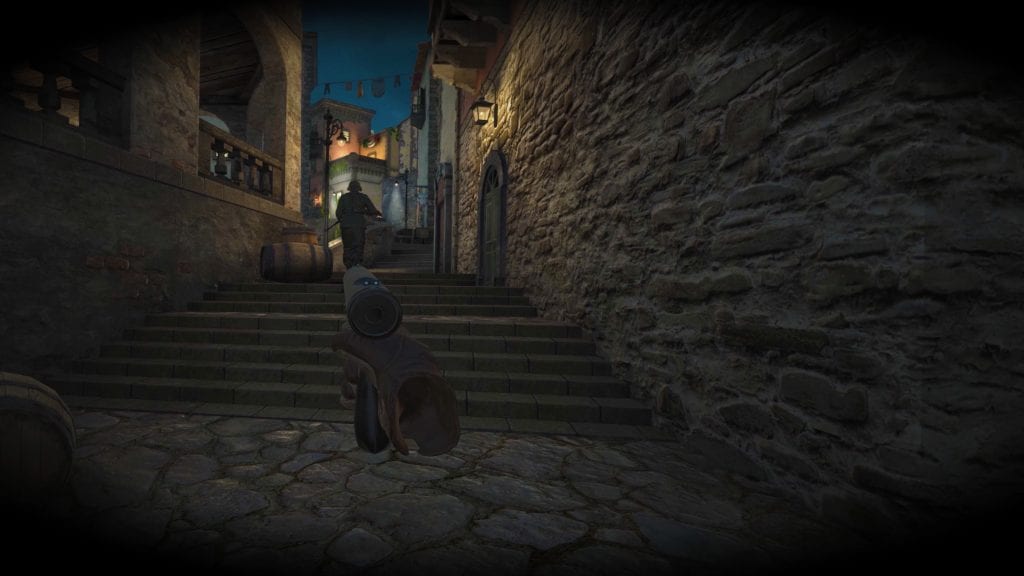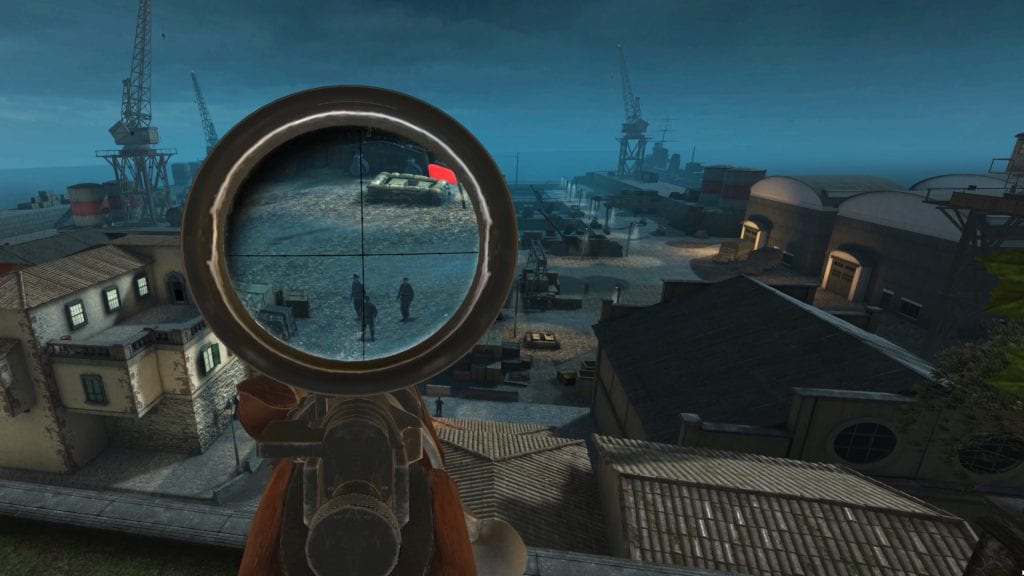*Disclaimer: Sniper Elite VR review code was provided by Rebellion for the purposes of this review. That being said, all opinions expressed in this review are entirely that of the author.
Sniper Elite shot onto the scene in 2005, delivering some bold third-person shooting mechanics that emphasised skill and precision over spraying and praying. After 3 subsequent releases, that same integral gameplay formula has been refined almost to perfection. While it may not be for everybody, Sniper Elite is a franchise that consistently provides a solid and unique shooter experience, and despite some pretty infuriating aspects, Sniper Elite VR is no different.
A New Take On a Refined Formula
Sniper Elite has a particular gameplay formula that it’s stuck to since day one. You’re given a sniper rifle, a secondary rifle, a pistol, and you’re set on missions that involve a mixture of light stealth and careful sniping. Rebellion had a pretty big task on their hand with Sniper Elite VR– transferring this same formula not only into a new first-person perspective, but also craft it to be an immersive VR experience. Thankfully, the transition is seamless.
Despite the new perspective and platform, nothing’s really changed. And that’s generally a good thing. Taking the time to line up and execute the perfect sniper shot is something baked into the DNA of Sniper Elite, and it’s all-the-more satisfying in VR. The trademark Kill Cam returns, this time putting the visceral breaking of bones and exploding organs directly in your face every time you achieve a particularly impressive kill.
Stealth, while not as intuitive as the usual third-person perspective, is definitely still an integral part of the game. The AI is generally quite forgiving, with detection meters being clear and easy to read in the moment. Silenced weapons make some of the stealth-focused missions much easier, but you don’t unlock the silenced rifle until the closing missions of the game, forcing you to use the silenced pistol or time your sniper shots with periodic loud noises like explosions or cannon fire. This can be a little irritating if you have little patience like me, but nailing an entire mission without alerting a single soldier is undeniably satisfying.

Technically Wonderful
Something that I wasn’t really expecting before I went in to Sniper Elite VR was for it to be such a technical marvel. After about three years of playing my PSVR, I’d like to think that I’ve run the gamut of what’s available on the platform. From barebones titles like RIGS to masterpieces of immersion such as Walking Dead: Saints & Sinners, I’ve played them all. So you can trust me when I say that Sniper Elite VR is very impressive, at least for a PSVR game.
Each environment is surprisingly immersive and quite varied. Whether you’re sneaking through underground Nazi bases or sniping from church towers, you’ll believe you’re there. Character models are realistic, weapon models are varied and interesting to look at, and the draw distance may be the best technical feature of the game, often allowing you to see the entire stage before you with no loading screens or awkward PS1-era “fog” that sometimes plagues even the most immersive PSVR experiences. The sound design should be commended as well here as each loud crack of a sniper shot and each low “thwip” of a silenced bullet helps only to immerse you further into the experience.
There’s Little Variation In War
Unfortunately, Sniper Elite VR may have copied its predecessors’ formula a little too well, especially with regards to mission structure. Both in the previous games and in this one, missions tend to follow the same general structure: you sneak, you snipe, you repeat. This structure is followed to a tee here, only this time it arcs over several missions. You’ll start with a stealth mission, followed by a sniping mission, then followed by a stealth mission and so on. While objectives do technically change between planting a bomb, stealing documents, defending a base against waves and the like, you’re essentially employing the same gameplay tactics repeatedly.
That being said, the varied settings helps to make each mission feel somewhat unique and different from one another. Despite one or two reused maps, each of the 18 stages takes place in a variety of Italian-based locales. From farmhouses to beaches to oil refineries, each one offering new buildings and structures to tentatively navigate your way around.
Similarly, there’s a large array of weapons in the game. Fans of WW2 shooters are sure to notice mainstays like the Springfield, Mosin-Nagant and the Lee Enfield, along with secondary rifles like the Trench Gun, Sten and MP40. While the sound design and reload animation for each weapon is unique, a lot of the weapons feel pretty similar. There isn’t much benefit in using this variety besides an arbitrary challenge mechanic that requires you to get a certain number of kills with each one.
One Too Many Stray Bullets
For all its technical prowess, Sniper Elite VR has one glaring issue: its controls. On PSVR, players can use the Dualshock, Motion controllers, or the Aim controller (the big plastic gun). Regardless of which method you use, I find you’re almost guaranteed to have a rough time in some way.
Let’s start with the two Motion controllers. While the outdated design of these PS3 wands is far from perfect, many PSVR titles make great use of them. AAA titles like Blood and Truth and the aforementioned Walking Dead: Saints & Sinners use these controllers intuitively for every command. Whether you’re manually reloading, dashing between cover, or impaling zombies, these actions are often pretty seamless thanks to some great behind-the-scenes technical work that adapts to the PSVR’s awkward tracking. Unfortunately, Sniper Elite VR just doesn’t work quite a lot of the time.
To put it simply, your PSVR camera is tracking you by the lights on the end of each controller and your headset. Now, the PSVR camera isn’t all that great at distinguishing which light is which, often leading to your in-game hands shifting suddenly whenever the lights on the controllers interfere with each other. This tracking is always an issue in games that ask you to use both hands to hold a rifle as the camera only sees one big blob of blue light emanating from your headset and the two controllers. In a game centred around holding a rifle with two hands, this isn’t great.
Bringing a sniper scope up to your face, cocking a shotgun, and even manually reloading a magazine into a pistol (which can be turned off) can sometimes take multiple attempts before the game just decides to work. In a game that emphasises careful planning and tense life-or-death battles, these tracking issues can actively ruin the entire experience. There’s only so many times you can “hold down the Options Button to re-centre your game” before you start to wonder why you’re wasting your time.

However, more positively, the Aim controller at least works some of the time. Thanks to the inclusion of dual analog sticks, moving your character is no longer a tenuous chore. Your two-handed rifles can now be aimed and manually reloading is removed entirely from the equation. That being said aiming down your sniper scope often still just doesn’t work. When you aim down the scope of your sniper (as you are wont to do in a game called “Sniper Elite”), the back of the gun will often gradually drift to the side, as though it’s mocking you for daring to take longer than a second to aim your shot. This is often just a bit irritating, making you re-centre your game repeatedly and sometimes fiddle with your camera, but there are some missions (the one where you have to silently snipe a general over 400m away comes to mind) in which this becomes particularly frustrating. I can deal with a lot of tracking issues with PSVR, but when Firewall: Zero Hour and its impeccable Aim implementation exists, I can’t give Sniper Elite VR the leniency it so consistently asks for.
When It Works, It Really Works
When Sniper Elite VR gets going on all cylinders and actually works, it really does work. There’s one mission about halfway through the game where it just clicked for me. I forgot about the tracking issues and the limited variety of mission objectives and just felt truly, honestly immersed.
In a mission called “Sabotage”, you take up a sniping position along a cliff’s ridge and take out targets in a fuel depot below, guiding your Partisan comrade through the depot with each kill. This simple structure brings out the best in this newly translated Sniper Elite formula. If you decide to use stealth, you’ll be tasked with timing your sniper shots with various machinery noises which gives you just enough time to pick out a target, line up the perfect shot, and watch as your bullet flies through the air and rips your target apart. Here, the Kill Cam feels like a reward for your patience and skill.
But, this highlights the real tragedy of Sniper Elite VR. Behind some glaringly frustrating tracking issues and some minor nit-picks there is a good game here, a great one maybe. I’m just personally finding it very difficult to see that. After spending around 10 hours with the game I genuinely feel as though I only had fun for about half that time, with the other half being filled with checking the camera, holding the options button and checking the settings.
With that being said though, Sniper Elite VR is definitely one of the higher-end PSVR titles when it works. If you’re dying for a new PSVR game or you’re still desperately trying to justify spending £50 on that big plastic gun, you might be willing to look past those controller frustrations and see Sniper Elite VR for the fun and immersive game buried within.
Final Verdict: 7/10
Sniper Elite VR is available now on PSVR, SteamVR, Oculus Rift, and Oculus Quest.
Words By Cameron Swan

Excellent, detailed and well-written review. Thanks!